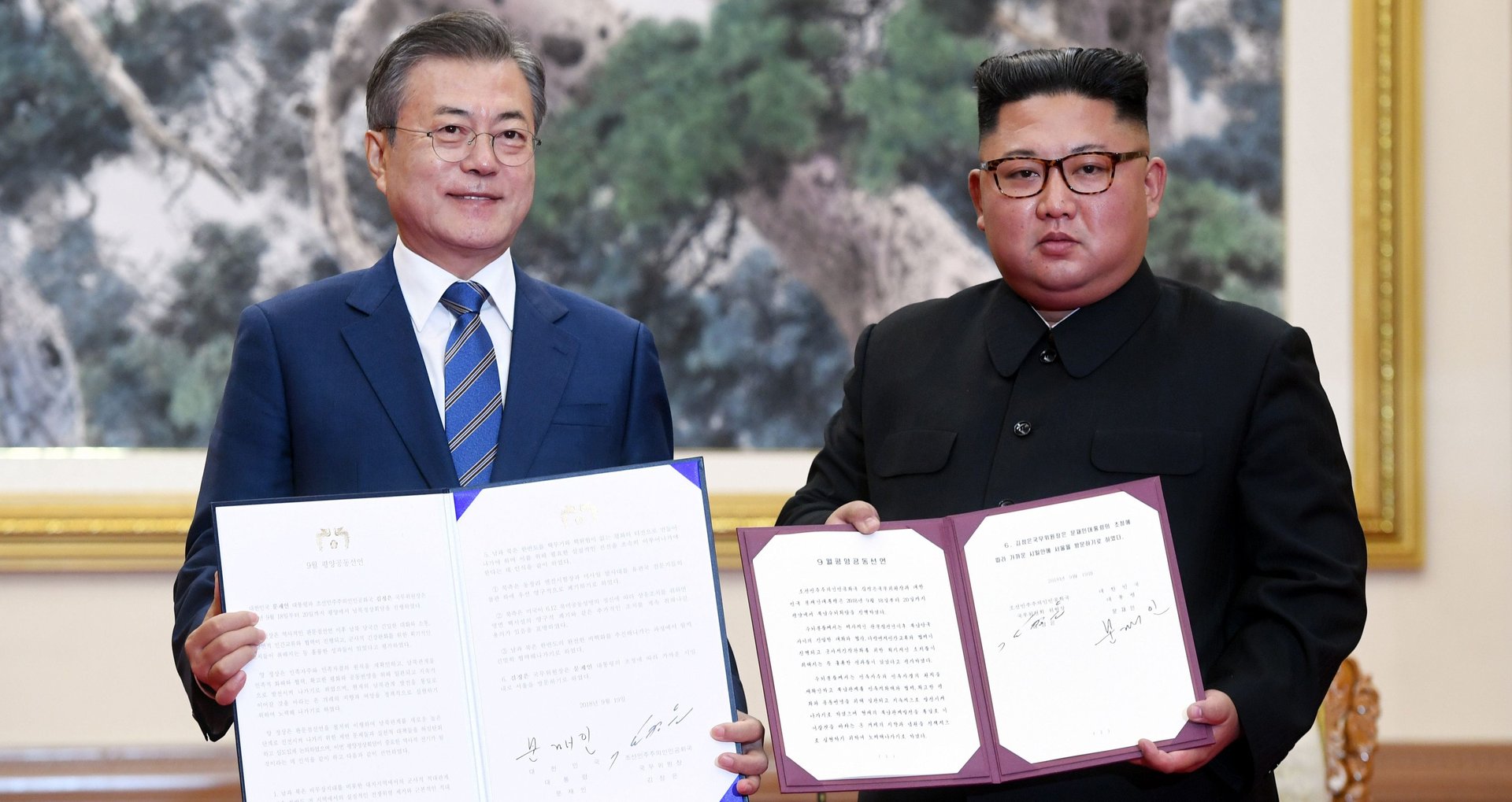Everything North and South Korea agreed to at the Pyongyang summit
On the second day of a three-day summit between Moon Jae-in and Kim Jong Un, the leaders of the two Koreas made bold declarations that Pyongyang was on its way to denuclearization.


On the second day of a three-day summit between Moon Jae-in and Kim Jong Un, the leaders of the two Koreas made bold declarations that Pyongyang was on its way to denuclearization.
The South Korean president exhorted that total denuclearization was “not far away“ (paywall), while Kim said he was “committed to working toward a peaceful peninsula without nuclear weapons or nuclear threat.”
The so-called September Declaration included commitments to varying degrees of denuclearization, including a pledge to shut down a missile launch pad and to allow international inspectors to the site. Melissa Hanham, a senior research associate at the James Martin Center for Nonproliferation Studies in Monterey, California, laid out in a Twitter thread that the agreement ultimately still falls short of a real commitment by Kim to give up his nuclear weapons, and that what he agreed to did not rule out the possibility that Pyongyang could continue to test missiles from other locations, including from mobile launchers.
Duyeon Kim, an adjunct senior fellow at the Washington DC-based Center for a New American Security, said the nuclear issue simply hasn’t “moved forward.”
However, insofar as Moon’s goal was to try to bridge the gap between North Korea and the US and keep relations between the two smooth, some believe that the South Korean president was successful. Andrei Lankov, a veteran North Korea watcher in Seoul, said that it was in South Korea’s interest to “create an impression that the North Koreans are willing to denuclearize even if this has no relation to reality,” as both sides are worried that the US could revert to its policy of “maximum pressure.”
Mintaro Oba, a former US diplomat with a focus on North Korean diplomacy, said that North Korea managed to show that it’s still “acting in good faith” with its latest commitments, while Seoul is using diplomacy to push the US to re-engage with Pyongyang as relations between the two countries have soured recently.
For his part, Donald Trump tweeted that he was “excited” at the outcome of the summit. Moon will visit the US on Sept. 25 to discuss the summit in North Korea with Trump. Only then may we know what the US president plans to do with the ball that Kim has so firmly planted in his court.
Nuclear weapons
- North Korea will shut down its Dongchang-ri missile launch pad near the Chinese border and allow international inspectors (paywall) to the site.
- North Korea will take further measures such as dismantling the large nuclear complex in Yongbyon if the Trump administration adheres to the June agreement signed in Singapore between the two countries and takes “corresponding measures,” without elaborating.
- There was no mention of other nuclear or launch facilities, including ones unknown to the outside world.
Demilitarization
- Both Koreas agreed to withdraw 11 guard posts along the Demilitarized Zone (DMZ) by December.
- The two sides will establish buffer zones on their land and sea borders.
- A no-fly zone will be established above the land border between the two countries.
- A joint military committee will be established to further reduce military tensions, a proposal that was also floated in 1991 to no avail.
Economy
- The two countries will break ground on connecting roads and trains between the two countries by the end of the year.
- Economic cooperation at the industrial complex at Kaesong and tourism at the Mount Kumgang resort could resume depending on conditions. The Kaesong complex was closed in 2016, and the Mount Kumgang resort in 2008.
Culture
- The two Koreas will file a joint bid to host the 2032 Olympics, and plan to cooperate in the 2020 Tokyo Olympics. (There have been talks for them to compete together.)
- Kim said he would visit Seoul “in the near future,” the first visit by a North Korean leader to the South.
- An art troupe from Pyongyang will visit South Korea in October.
Family reunions
- Both sides will work toward allowing families separated by the Korean War to hold reunions by video.
- A permanent meeting point will be built in Kaesong in North Korea to allow families to meet.